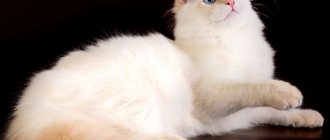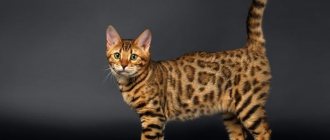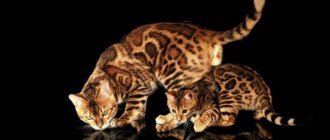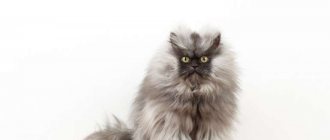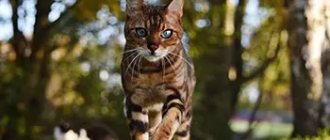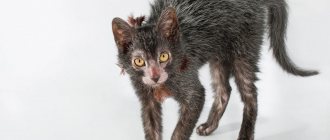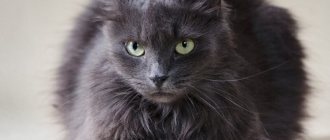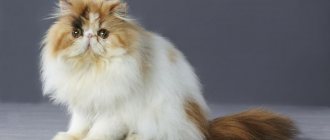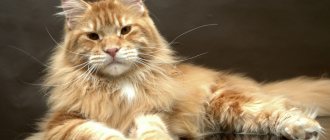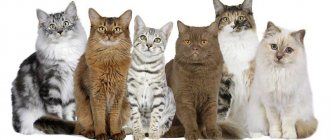A cat's rich coat is a calling card, an adornment, and, with proper care, a reason for admiration. Of course, with long hair, the number of nuances in caring for a pet increases, but for true lovers, this is not a hindrance. Especially for those who like to while away their evenings brushing their pet’s fur coat, we decided to list all the fluffy cat breeds - take your pick.
Note! Fluffy cats in the general sense are animals with long hair and, less commonly, cats with a semi-long, but “stuffed” coat.
Features of care
Fluffy cats are very cute and beautiful. However, when planning to have such a pet, owners should know the basic rules for caring for it:
- Combing . Long and fluffy fur requires special attention. Such cats should be combed daily with a special comb to avoid the formation of tangles, improve the condition of the coat, and speed up the shedding process.
- Hygiene . Proper care of cats of fluffy breeds involves regular hygiene procedures. Pets should clean their eyes and ears daily using a cotton swab. When cleaning the ear canal, a cotton swab or swab should be pre-treated in vegetable oil. A solution of boric acid is also suitable for these purposes.
- Haircuts . Periodic visits to the cat groomer and regular haircuts, which are recommended to be done every few months (at least once every six months), can improve the condition of the pet’s fur and appearance.
- Bathing . Fluffy cats need bathing and water treatments, which are necessary even if the animal does not leave the house or go outside. The fact is that thick wool and undercoat, one way or another, accumulate dust. Bathing (read how to wash a cat) is recommended to be done once every 1-2 months, using for this purpose a special cat shampoo, which can be purchased at veterinary pharmacies and specialized stores. Often, owners of long-haired pets are faced with the problem of water intolerance in their cats. In this case, you should buy a special dry shampoo and clean your pet’s fur with it.
- Nutritional Features. Cats with fluffy, long coats often swallow hair when eating food, which can lead to disturbances in the functioning of the gastrointestinal tract, problems with appetite, nausea and vomiting. This can be avoided by using special food that helps remove hair from the animal’s body. Also, good results are obtained by adding fresh grass to your pet’s diet, which you can grow yourself at home on the windowsill.
In all other respects, caring for furry cats is almost identical to caring for other pets. Love, attention, maintaining a water regime, vaccinations and regular visits to the veterinarian - that’s all that is necessary for a cat’s vigor, health and longevity.
I and II categories according to FIFe
Most of the breeds recorded in this association are recognized by other large communities. Documents of the World Felinological Club have.
American Longhair Curl
A large cat with characteristic upturned ears.
Read more in the article about the American Curl.
Balinese cat
A breed offshoot from Siamese ancestors. They have semi-long, rather hard fur, and are most often color-point in color. The animals have a friendly disposition and are excellent playmates for children.
More about Balinese is written here.
British
Noble cats with thick plush fur.
Read articles about British shorthair and longhair cats.
Himalayan cat
Phenotypically and in character, they are similar to their Persian relatives, but have clear blue eyes and a contrasting colorpoint color.
Read more about this cat here.
Maine Coon
Not only fluffy, but also a large breed. Despite their wild and predatory appearance, they are very affectionate and tame.
Read a lot of interesting information about the origin, character of Maine Coons, as well as their care here.
Persian breed
Record holders for fur length. Sometimes it can reach twenty centimeters in length.
Much has been written about these mega-furry creatures here.
Did you know that this fluffiest cat in the world is actually prone to aggression? Read about this, as well as about other most evil cat breeds.
Burmese breed
Outwardly, it is also similar to the Siamese, but differs in white socks and a more rounded head shape.
Read a lot of interesting information about this breed in the article about Burmese.
Siberian cat
An ancient variety with a long history and a characteristic exterior inherited from their northern forest ancestors.
Read about these amazing forest cats in the article here.
Neva Masquerade
They were bred from Siberians, and differ from them in their blue eyes and color-point color.
Read more in the article about the Neva Masquerade.
Turkish Angora
Noble animals with unusual dense soft fur.
About this extraordinary snow-white cat
What diseases are furry cats prone to?
Fluffy cat breeds are especially susceptible to skin diseases. The following factors can provoke this disease:
- overfeeding;
- vitamin deficiency or hypervitaminosis;
- improper grooming;
- lack of a balanced diet.
For this reason, when getting a fluffy kitten, it is strongly recommended to consult with a veterinarian, who will help you create the right menu for your pet and explain the features of caring for it.
Basic concepts - what is a breed and how many cat breeds are there?
Is your only selection criterion the length of your pet's fur? In this case, your hands are free, because among mestizos and outbred animals there are a lot of very beautiful cats, which sometimes live on the street and are in dire need of care. The situation will be a little more complicated if you are a fan of only purebred animals and want to get a pet with a certain character.
How many cat breeds do you think there are? If you collect all open data, the figure reaches 700! However, this figure is very far from the truth. A purebred animal has documents! Pedigree and metrics, that is, official papers confirming its origin and compliance of the exterior with the breed standard. Each purebred cat is registered in the club, and the club is registered in one of the felinological organizations. This is where the fun begins. There are hundreds of breed organizations in the world and only three authoritative “parent” clubs:
- The World FIFe – International Cat Federation – recognizes 42 breeds.
- The European WCF - World Cat Federation - recognizes 70 breeds.
- The American CFA - Cat Fanciers Association - recognizes 40 breeds.
You need to understand that the above data is quite flexible, the chance for recognition of a new breed exists every day, and recognized breeds are duplicated in registries. So, from 700, we came to 100–110 species that are officially recognized in the world and have the right to participate in exhibitions. In addition to these breeds, there are a number of mixed/experimental groups - mestizos, hybrids, etc. Breeding work on breeding new breeds is carried out only with the permission of the parent clubs and is strictly controlled. That is, if you are offered to buy a half Persian and half Angora, this is not a new breed, and not a breed at all - it is a mestizo! A kitten from two Persians without pedigrees is not a breed, but a phenotype.
Nibelung
The long-haired version of the Russian Blue cat is considered quite rare among breeders. Translated from German, the name means “creation of fog.” Indeed, the fur of these magnificent creatures is like a fabulous blue mist. It is believed that the main color is blue, but the tips of the hairs are white. In sunlight it creates a stunning shine effect.
Nibelugas are large cats with a strong, muscular body. The body is covered with thick undercoat, which adds additional volume to the size of the cat. To keep the coat in good condition, it is necessary to comb it at least twice a week.
Ural Rex (long-haired)
This breed has been around for many years, but it is not as popular as, say, the Siberian. The first kitten with unusual curly hair appeared in a village in the Sverdlovsk region in 1988, three years later they were officially described by Russian felinologists.
They are a well-built, sturdy, medium-sized cat, they look less fluffy than many other breeds, but boast cute curls that give them a voluminous and original appearance. There is also a peculiar mane. Almost all colors are recognized, with the exception of cinnamon and chocolate.
"Royal" nicknames
Oversized, large, fluffy cats most often go well with names associated with a high position in society. And even if the owner is holding a tiny purring lump in his arms, he has the right to “try on” a very titled nickname for the pet or one that hints at the “importance” of its owner:
- Basil (English: royal);
- Baron;
- Master;
- Basie (English: royal);
- Buckingham (Duke);
- Vazil (Bulgarian – king);
- Vasilis (Greek – king);
- Vasius (Greek - royal);
- Walden (German – ruler);
- Waldo (ancient German - ruler);
- Viscount;
- Vizier;
- Walter (German – strong ruler);
- Duke;
- Gerrick (ancient German – strong and rich);
- Herald (English - commander);
- Infant;
- Marquis;
- Chevalier.
Pros and cons of tailless cats
Keeping tailless cats does not differ from the rules that have been established for other breeds:
- Weekly brushing (daily during shedding period).
- Swimming does not create problems for owners of aboriginal bobtails - the animals love water and willingly enter it.
- All short-tailed cats are attached to people and devoted to their owner.
- Stable immunity and good genetics mean that representatives of these breeds are not prone to hereditary diseases.
- Short-tailed cats are not long-livers, but with satisfactory care, all breeds consistently live up to 15 years.
Many people consider short-tailed cats to be strange, not quite ordinary animals. In fact, representatives of tailless groups are distinguished by their outstanding intelligence and good health. If one day a person gets a cat with a small pom-pom tail, then in the future he will never become a fan of another breed.
Oriental Longhair
Native to North America, this breed is a mix of Siamese and Shorthair.
Most often it has solid, tabby and smoky colors. Color is the main distinguishing factor from the Balinese cat.
Representatives of long-haired Orientals have a friendly and easy-going character, however, like any pet with long hair, they require special care. It is believed that these cats easily and firmly become attached to their owners, remember this when getting a kitten of this breed.
Strong build, soft fluffy fur combined with grace and dexterity.
American Curl
The history of this breed begins with a strange stray cat with characteristic crescent-shaped, backward-curved ears. The first litter of kittens from this mother was obtained in California. It is characteristic that when mating with other breeds, among the newborns there are always “eared” individuals. This feature of the breed should be taken into account when stroking the animal’s head; this should be done carefully so as not to damage the fragile ear cartilage.
Curls have a dense, thick, silky coat that requires moderate grooming. The color can be very varied. At the same time, kittens are born snow-white, only acquiring color with age.
Cymric
This is another tabby cat with a short tail. The ancestors of this breed come from Maine. They were obtained by crossing a short-tailed cat with a long-haired breed. She is very rare. By the way, the breed is called the Celtic tribe.
The Cymric has a large, rounded head. They have large cheeks and a large chin. The ears are set wide apart and are rounded at the tips. The compact body is well developed. The back of the body is slightly raised (the hind legs of the animal are longer than the front). The tail is missing; in its place there is a small, inconspicuous cartilage.
Cymriki are friendly and playful. The animal does not play pranks: it does not scratch furniture, does not climb curtains, and does not knock over objects. He gets along well with children and never uses his claws. Like the American Bobtail, the Cymric does not tolerate loneliness.
Kurilian Bobtail
Very fluffy cats - in the long-haired version, bobtails are compared to manul cats. Powerful, compact, with a raised croup and a short tail, tassels on the ears. There are spinal defects in the gene pool. If there are no congenital diseases, excellent health - the indigenous breed is long-lived.
Despite their harsh appearance, they are affectionate and tame pets. They need close contact with their family and love to play. With children they are gentle and patient, even in a peak situation they do not let out their claws until the last moment. Brave, decisive, excellent hunters - they destroy rats and ferrets in chicken coops, moles, even snakes. They are self-sufficient and tolerate loneliness well.
Maine Coon - from 3.6 to 11.3 kg
The Maine Coon is one of the largest cat breeds native to Maine, USA. On average, males weigh from 6.8 to 11.3 kg, and sometimes larger individuals are found, while females weigh less, from 3.6 to 5.4 kg. The Maine Coon has a muscular body with a wide chest. The coat is long and thick. These cats have tufts on their ears. Maine Coons are ideal for the extreme climate conditions of Maine.
They are loyal and affectionate animals, however they are not inclined to sit on a person's lap all the time, and will only come on their own terms when they are ready. They demonstrate independence, but are also capable of charming. The Maine Coon is an ideal pet that gets along well with children, dogs or the elderly. This smart cat needs to be given a lot of toys, since the Maine Coon has strong hunting instincts, so the breed is not suitable if the family has pet rodents.
Napoleon
In essence, this is an offshoot of the Munchkin breed, their close, but much more miniature and fluffy creatures.
These cats are among the most expensive due to the unique small size and fluffiness of the Persians (crosses with which were carried out during the breeding of the line). Their front legs are shorter than their hind legs, and their short ears end with sharp tips.
These babies are distinguished by their gentle and devoted character.
Ragdoll - from 4.5 to 9.0 kg
The Ragdoll is a breed of large semi-longhaired cat with amazing blue eyes, native to the USA. Their body is light, but there are dark spots on their face, ears, legs, back and tail. Adult males typically weigh over 6.8-9.0 kg; females are smaller and typically weigh between 4.5 and 6.8 kg at maturity. These cats mature slowly, reaching adult coat color at two years and size and weight at four.
Ragdoll cats tend to be more interested in people than most other breeds. They are known to run to greet their owner at the door, follow them from room to room, climb into arms, sleep on beds, and constantly need human company. They are gentle cats and usually do not scratch while playing. Overall, the Ragdoll is well-behaved and easy to care for. The breed is ideal for our modern, busy lifestyle.
Laperm
The Rex breed can boast of long hair and the presence of a fluffy “curly coat”. During their life, they completely change their woolen outfit several times. They often look a little disheveled, often have a pronounced “collar”, the coat is elastic, loose and very light. If you blow on it, it is easy to expose an area of the body.
Individuals are medium to large in size, their beautiful almond-shaped eyes widen when they sense danger. Cats have a funny tail that resembles a bottle brush.
Turkish Angora
Owners of a bushy tail and no less luxurious fur. Not very large, reaching 2.5 kg in weight. Clean and without a dense undercoat, despite their long hair, they are easier to care for than, for example, Persians. Many owners note the love of these cats for water procedures.
There are a wide variety of colors from cream, charcoal, blue and white to the more interesting merle, brindle and different variations of tabby.
This breed is distinguished by unusual eye pigmentation; in addition to the standard green, heterochromes and blue eyes are often found.
Siberian
The ideal embodiment of a truly Russian pet is a good-natured character, a strong physique and a warm fur coat. The very name of the breed evokes associations with a broad soul and incredible, wild beauty. Siberians are strongly attached to the house and owner, although they can go for a walk. They patiently endure the cuddles of children and are not vindictive at all, since even adult cats always remain kittens at heart. Despite their playful disposition, Siberians are smart. They instantly understand the essence of prohibitions and never repeat dangerous mistakes, respecting the authority of the owner. They quickly understand what is wanted from them, so there are never any problems in raising the breed.
Neva Masquerade
This breed is often considered a variety of the Siberian cat, however, in 1992 it was recognized as an independent cat. In fact, she shares 5th and 6th place with the ancestor of the suit close to her.
The color of these fluffy beauties contains the Siamese cat gene, which gives them a characteristic silver-blue color. However, variations of black-brown and orange-white are possible. The most interesting thing is that the body is always a lighter shade, while the muzzle, ears, tail and paws are in darker contrast. It looks elegant. Hence the name.
The thick, dense coat changes twice a year. The mustachioed pet has massive fluffy paws and a luxurious bushy tail.
Ragamuffin
These cats will not leave anyone indifferent! A magnificent large cat with large expressive eyes. You just want to hug her fluffy body.
A wide variety of colors from white and black to striped, brindle and tortoiseshell, as well as interesting patterns on the coat make this breed very popular!
Ragamuffins have a rabbit-like feel and require a lot of attention and care.
Breeds that are only recognized by the CFA
Of the above, the CFA recognizes all except:
- American Bobtail. Similar to other short-haired representatives of its breed, but has a different head shape and rounded ears with tassels.
AMERICAN BOBTAIL, AMERICAN BOBTAIL
- Pixiebob. He is classified as a fluffy munchkin, although he is distinguished by his ear tufts.
PIXIE BOB, PIXIE BOB
- Ojos azules.
Who is not on the CFA list of fluffy cat breeds: American Ojos Azules
